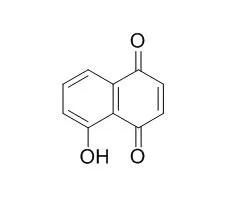| In vitro: |
| Basic Clin Pharmacol Toxicol. 2015 Jun;116(6):460-7. | | Enhanced eryptosis following juglone exposure.[Pubmed: 25348830 ] | Juglone, a quinone isolated from Juglans mandshurica Maxim, has previously been shown to be effective against malignancy. The effect is at least partially due to stimulation of suicidal death or apoptosis of tumour cells. On the other hand, Juglone has been shown to counteract apoptosis, for example, of neurons. In analogy to apoptosis of nucleated cells, erythrocytes may enter eryptosis, a suicidal death characterized by cell shrinkage and breakdown of phosphatidylserine asymmetry of the cell membrane with phosphatidylserine exposure at the erythrocyte surface. Stimulators of eryptosis include increase in cytosolic Ca(2+) activity [(Ca(2+) )i ].
METHODS AND RESULTS:
This study explored whether Juglone stimulates eryptosis. To this end, erythrocyte volume was estimated from forward scatter, phosphatidylserine exposure at the erythrocyte surface from FITC annexin V binding, ceramide abundance from binding of fluorescent antibodies in flow cytometry and cytosolic ATP with a luciferin-luciferase-based assay. As a result, a 24-hr exposure of human erythrocytes to Juglone (5 μM) significantly decreased erythrocyte forward scatter. Juglone (1-5 μM) significantly increased the percentage of annexin V binding cells. Juglone (5 μM) significantly increased ceramide abundance at the erythrocyte surface and decreased erythrocyte ATP concentration. The effect of Juglone (10 μM) on annexin V binding was slightly but significantly blunted by removal of extracellular Ca(2+) and by addition of protein kinase C (PKC) inhibitor staurosporine (1 μM).
CONCLUSIONS:
In conclusion, Juglone stimulates suicidal erythrocyte death or eryptosis at least in part by upregulation of ceramide abundance, energy depletion and activation of PKC. | | Xi Bao Yu Fen Zi Mian Yi Xue Za Zhi. 2015 Feb;31(2):186-9. | | Juglone inhibits proliferation and induces apoptosis of human cervical squamous cancer SiHa cells[Pubmed: 25652859] | To explore the effect of Juglone on proliferation and apoptosis of human cervical squamous cancer SiHa cells.
METHODS AND RESULTS:
Cultured SiHa cells in the exponential growth phase were grouped into blank control group and 10, 20, 50, 80 and 100 μmol/L Juglone treatment groups. Methyl thiazolyl tetrazolium (MTT) assay was adopted to observe the inhibitory effect of Juglone on the proliferation of SiHa cells, and then 50% inhibitory concentration (IC50) was calculated through formula. Annexin V-FITC/PI double staining and flow cytometry were used to detect the effect of 20 μmol/L Juglone on SiHa cell apoptosis. Western blot was applied to determine the expressions of Bcl-2 and Bax. MTT assay showed that, compared with the control group, treatment groups all showed significant inhibitory effects on SiHa cell growth, and IC50 was 20.4 μmol/L. Flow cytometry demonstrated that early apoptosis rate of SiHa cells in the control group was (2.46 ± 0.37)%, and after treatment with 20 μmol/L Juglone for 12 hours, the apoptosis rate was raised to (18.47 ± 2.26)%; Western blot analysis showed that the expression of Bcl-2 decreased while the expression of Bax increased significantly in SiHa cells treated with 20 μmol/L Juglone.
CONCLUSIONS:
Juglone could significantly inhibit the proliferation and induce the apoptosis of SiHa cells. |
|
| In vivo: |
| Biochem Biophys Res Commun. 2015 Jul 3;462(3):245-50. | | Juglone prevents metabolic endotoxemia-induced hepatitis and neuroinflammation via suppressing TLR4/NF-κB signaling pathway in high-fat diet rats.[Pubmed: 25964086] | Juglone as a natural production mainly extracted from green walnut husks of Juglans mandshurica has been defined as the functional composition among a series of compounds. It showed powerful protective effect in various diseases by inhibiting inflammation and tumor cells growth. However, studies on its anti-inflammatory effect based on high-fat diet-induced hepatitis and neuroinflammation are still not available.
METHODS AND RESULTS:
In this regard, we first investigated whether Juglone suppresses high-fat diet-stimulated liver injury, hypothalamus inflammation and underlying mechanisms by which they may recover them. SD rats were orally treated with or without high-fat diet, 0.25 mg/kg or 1 mg/kg Juglone for 70 days. Subsequently, blood, hypothalamus and liver tissue were collected for different analysis. Also, the primary astrocytes were isolated and used to analyze the inhibitory effect of Juglone in vitro. Analysis of inflammatory cytokines declared that the inhibition of TNF-α, IL-1β and IL-6 could be carried by Juglone in response to high-fat diet rats. Meanwhile, TLR4 expression and NF-kappa activity also have been confirmed to be the key link in the development of hepatitis and nerve inflammation. The activation was significantly suppressed in treatment group as compared with model.
CONCLUSIONS:
These results indicated that Juglone prevents high-fat diet-induced liver injury and nerve inflammation in mice through inhibition of inflammatory cytokine secretion, NF-kappa B activation and endotoxin production. |
|






 Cell. 2018 Jan 11;172(1-2):249-261.e12. doi: 10.1016/j.cell.2017.12.019.IF=36.216(2019)
Cell. 2018 Jan 11;172(1-2):249-261.e12. doi: 10.1016/j.cell.2017.12.019.IF=36.216(2019) Cell Metab. 2020 Mar 3;31(3):534-548.e5. doi: 10.1016/j.cmet.2020.01.002.IF=22.415(2019)
Cell Metab. 2020 Mar 3;31(3):534-548.e5. doi: 10.1016/j.cmet.2020.01.002.IF=22.415(2019) Mol Cell. 2017 Nov 16;68(4):673-685.e6. doi: 10.1016/j.molcel.2017.10.022.IF=14.548(2019)
Mol Cell. 2017 Nov 16;68(4):673-685.e6. doi: 10.1016/j.molcel.2017.10.022.IF=14.548(2019)